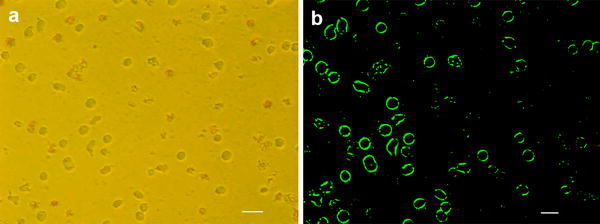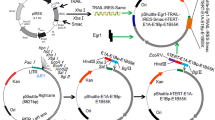Abstract
To study the inhibitory effects of caspase-3 mRNA antisense oligodeoxynucleotides (ASODNs) on apoptosis, we designed four ASODNs targeting different regions of caspase-3 mRNA and transfected them into human leukemia HL-60 cells. The transfected cells were given 10 Gy γ-irradiation followed by incubation for 18 h and measurement of apoptosis and caspase-3 expression. Our results showed that ASODN-2 targeting the 5′ non-coding region of sites –62 to –46, and ASODN-3 targeting the 5′ coding region of sites –1 to 16, both reduced apoptosis measured by gel electrophoresis and flow cytometry. Hoechst 33258 staining and TUNEL assay revealed that apoptotic indexes in the ASODN-2 and ASODN-3 groups were significantly lower than those in the untransfected and mismatched oligodeoxynucleotide (MODN) groups. Immunocytochemistry, Western blotting and RT-PCR showed that expression levels of caspase-3 protein and mRNA in both ASODN-2 and ASODN-3 groups were decreased compared with those in the untransfected and MODN groups. In conclusion, caspase-3 mRNA ASODNs can inhibit γ-radiation-induced apoptosis of HL-60 cells and reduce expression of caspase-3 protein and mRNA. The results suggest that antisense approach may be useful for therapeutic treatment of certain neurodegenerative diseases in which apoptosis is involved.








Similar content being viewed by others
References
Saikumar P, Dong Z, Mikhailov V, Denton M, Weinberg JM, Venkatachalam MA (1999) Apoptosis: definition, mechanism, and relevance to disease. Am J Med 107:489–506
Held KD (1997) Radiation-induced apoptosis and its relationship to loss of clonogenic survival. Apoptosis 2:265–282
Verheij M, Bartelink H (2000) Radiation-induced apoptosis. Cell Tissue Res 301:133–142
Hunter A, Hendrikse A, Renan M, Abratt R (2006) Does the tumor microenvironment influence radiation-induced apoptosis? Apoptosis 11:1727–1735
Harms-Ringdahl M, Nicotera P, Radford IR (1996) Radiation induced apoptosis. Mutat Res 366:171–179
Ward JF (1991) DNA damage and repair. Basic Life Sci 58:403–415
Petak I, Houghton JA (2001) Shared pathways: death receptors and cytotoxic drugs in cancer therapy. Pathol Oncol Res 7:95–106
Liebermann DA, Hoffman B, Steinman RA (1995) Molecular controls of growth arrest and apoptosis: p53-dependent and independent pathways. Oncogene 11:199–210
Kimura K, Gelmann EP (2000) Tumor necrosis factor-α and Fas activate complementary Fas-associated death domain-dependent pathways that enhance apoptosis induced by γ-irradiation. J Biol Chem 275:8610–8617
Embree-Ku M, Venturini D, Boekelheide K (2002) Fas is involved in the p53-dependent apoptotic response to ionizing radiation in mouse testis. Biol Reprod 66:1456–1461
Li XM, Tong X, Song TB et al (1999) Expression of caspase-3 gene in apoptotic HL-60 cell and different human tumor cell lines. China J Radiol Med Prot 19:297–299 (in Chinese)
Afshar G, Jelluma N, Yang X et al (2006) Radiation-induced caspase-8 mediates p53-independent apoptosis in glioma cells. Cancer Res 66:4223–4232
Hara S, Nakashima S, Kiyono T et al (2004) Ceramide triggers caspase activation during gamma-radiation-induced apoptosis of human glioma cells lacking functional p53. Oncol Rep 12:119–123
Zhuang S, Kochevar IE (2003) Ultraviolet A radiation induces rapid apoptosis of human leukemia cells by Fas ligand-independent activation of the Fas death pathways. Photochem Photobiol 78:61–67
Hosokawa Y, Sakakura Y, Tanaka L et al (2005) Radiation-induced apoptosis is independent of caspase-8 but dependent on cytochrome c and the caspase-9 cascade in human leukemia HL60 cells. J Radiat Res (Tokyo) 46:293–303
Fadeel B, Orrenius S (2005) Apoptosis: a basic biological phenomenon with wide-ranging implications in human disease. J Intern Med 258:479–517
Friedlander RM (2003) Apoptosis and caspases in neurodegenerative diseases. N Engl J Med 348:1365–1375
Matsui T, Ramasamy K, Ingelsson M et al (2006) Coordinated expression of caspase 8, 3 and 7 mRNA in temporal cortex of Alzheimer disease: relationship to formic acid extractable Abeta42 levels. J Neuropathol Exp Neurol 65:508–515
Gervais FG, Singaraja R, Xanthoudakis S et al (2002) Recruitment and activation of caspase-8 by the Huntingtin-interacting protein Hip-1 and a novel partner Hippi. Nat Cell Biol 4:95–105
Reed JC (2002) Apoptosis-based therapies. Nat Rev Drug Discov 1:111–121
Fischer U, Schulze-Osthoff K (2005) Apoptosis-based therapies and drug targets. Cell Death Differ 12(Suppl 1):942–961.
Probst JC (2000) Antisense oligodeoxynucleotide and ribozyme design. Methods 22:271–281
Nicholson DW (1999) Caspase structure, proteolytic substrates, and function during apoptotic cell death. Cell Death Differ 6:1028–1042
Benchimol S (2001) p53-dependent pathways of apoptosis. Cell Death Differ 8:1049–1051
Rich T, Allen RL, Wyllie AH (2000) Defying death after DNA damage. Nature 407:777–783
Haupt S, Berger M, Goldberg Z, Haupt Y (2003) Apoptosis – the p53 network. J Cell Sci 116:4077–4085
Mattson MP (2000) Apoptosis in neurodegenerative disorders. Nat Rev Mol Cell Biol 1:120–129
Yakovlev AG, Faden AI (2001) Caspase-dependent apoptotic pathways in CNS injury. Mol Neurobiol 24:131–144
Gervais FG, Xu D, Robertson GS et al (1999) Involvement of caspases in proteolytic cleavage of Alzheimer's Amyloid-beta precursor protein and amyloidogenic A beta peptide formation. Cell 97:395–406
Takuma H, Tomiyama T, Kuida K, Mori H (2004) Amyloid beta peptide-induced cerebral neuronal loss is mediated by caspase-3 in vivo. J Neuropathol Exp Neurol 63:255–261
Reddy PH, Williams M, Charles V et al (1998) Behavioural abnormalities and selective neuronal loss in HD transgenic mice expressing mutated full-length HD cDNA. Nat Genet 20: 198–202
Goldberg YP, Nicholson DW, Rasper DM et al (1996) Cleavage of Huntingtin by apopain, a proapoptotic cysteine protease, is modulated by the polyglutamine tract. Nat Genet 13:442–449
Cid C, Alvarez-Cermeño J C, Regidor I, Plaza J, Salinas M, Alcázar A (2003) Caspase inhibitors protect against neuronal apoptosis induced by cerebrospinal fluid from multiple sclerosis patients. J Neuroimmunol 136:119–124
Burkhard J, Zangemeister-Wittke U (2002) Antisense therapy for cancer—the time of truth. Lancet Oncol 3:672–683
Ingo T, Bernd D, Gunther H (2001) Antisense therapy in oncology: new hope for an old idea? Lancet 358:489–497
Gridley DS, Slater JM (2004) Combining gene therapy and radiation against cancer. Curr Gene Ther 4:231–248
Noguchi S, Hirashima N, Furuno T, Nakanishi M (2003) Remarkable induction of apoptosis in cancer cells by a novel cationic liposome complexed with a bcl-2 antisense oligonucleotide. J Control Release 88:313–320
Masui T, Hosotani R, Ito D et al (2006) Bcl-XL antisense oligonucleotides coupled with antennapedia enhances radiation-induced apoptosis in pancreatic cancer. Surgery 140:149–160
Acknowledgments
The work was supported by a grant from the National Natural Science Foundation of China (No. 39880008). We are most grateful to Prof. Dwight C. German (Department of psychiatry, University of Texas Southwestern Medical Center) for his suggestions and careful review of the manuscript.
Author information
Authors and Affiliations
Corresponding author
Additional information
The work was supported by a grant from the National Natural Science Foundation of China (No. 39880008).
Rights and permissions
About this article
Cite this article
Zhang, XT., Song, TB., Du, BL. et al. Caspase-3 antisense oligodeoxynucleotides inhibit apoptosis in γ-irradiated human leukemia HL-60 cells. Apoptosis 12, 743–751 (2007). https://doi.org/10.1007/s10495-006-0018-8
Received:
Accepted:
Published:
Issue Date:
DOI: https://doi.org/10.1007/s10495-006-0018-8




